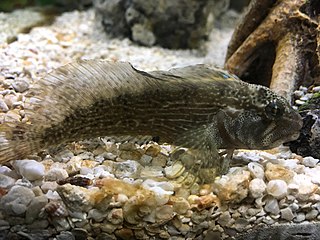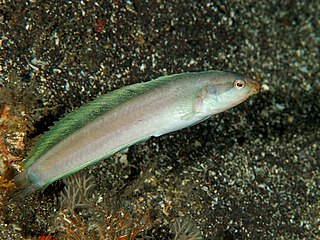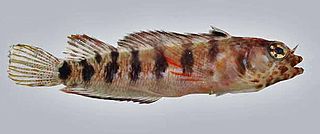
Selene brevoortii, the hairfin look down, also known as the airfin lookdown, Mexican lookdown or Pacific lookdown, is a species of carangid fish native to warmer parts of the East Pacific where it is found from southernmost California, United States to northern Peru. This species is generally found close to the coast at depths of less than 50 m (160 ft). They grow to 38 cm (15 in) in fork length. It is of minor importance to local commercial fisheries, but is popular as a gamefish. Its specific name honours the American book collector, numismatist, amateur naturalist and friend of Theodore N. Gills J. Carson Brevoort (1817-1887) for his interest in the fishes of the family Carangidae.

The Kirk's blenny is a species of combtooth blenny in the genus Alticus. It was described by A. Günther in 1964, originally as a member of the genus Salarias. It is a tropical blenny which is known from the Red Sea, Mozambique, Réunion, the Persian Gulf, and India, in the Indian ocean. Kirk's blennies inhabit waters near the shore, and often spend time out of the water. They are able to breathe air when on land. They are oviparous, and form distinct pairs when mating; they also guard their eggs. They can reach a maximum total length of 11 centimetres, and feed primarily off of benthic algae.
Antennablennius simonyi, Simony's blenny, is a species of combtooth blenny found in the western Indian Ocean, from the Gulf of Aden to the Persian Gulf. The specific name honours the Austrian mathematician and entomologist Oskar Simony (1852-1915), who looked after the collection of fish specimen on an expedition to Socotra on which the type was collected.

Chasmodes bosquianus, the striped blenny, is a species of combtooth blenny found in the western Atlantic ocean, from New York to Florida. The specific name uses the suffix-ianus to denote "belonging to" and refers to the French naturalist Louis Augustin Guillaume Bosc (1759-1828), whose notes Bernard Germain de Lacépède used to base his description of this blenny.

Hypleurochilus springeri, the orange-spotted blenny, is a species of combtooth blenny found in coral reefs in the western Atlantic ocean. This species grows to a length of 5 centimetres (2.0 in) TL. The specific name honours the American ichthyologist Victor G. Springer.
Istiblennius colei is a species of combtooth blenny found in the western Pacific Ocean, around the Philippines. Males of this species can reach a maximum of 11.8 cm (4.6 in) SL, while females reach a maximum of 10.3 cm (4.1 in) SL. The specific name of this blenny honours Howard I. Cole (1892-1966) who was the Chief Chemist for the Philippine Health Service at the leper colony on Culion Island, Philippines, which is the type locality.
Petroscirtes pylei, the twilight fangblenny, is a species of combtooth blenny found in the western central Pacific ocean, around Fiji. This species reaches a length of 4.1 centimetres (1.6 in) SL. The specific name honours the American ichthyologist Richard L. Pyle of the Bishop Museum in Honolulu.

Petroscirtes springeri is a species of combtooth blenny found in coral reefs in the northwest Pacific ocean. This species reaches a length of 7.7 centimetres (3.0 in) SL. The specific name honours the American ichthyologist Victor G. Springer of the United States National Museum, it was Springer who first introduced the author to the blenniids and who suggested the study in which Smith-Vaniz described this species.
Ecsenius kurti, Kurt's coralblenny, is a species of combtooth blenny in the genus Ecsenius. It is found in coral reefs in the western Pacific ocean; it is endemic to the Cuyo Islands of the Philippines. It can reach a maximum length of 3.5 centimetres. Blennies in this species feed primarily off of plants, including benthic algae and weeds. The specific name honours Kurt A. Bruwelheide, who was a museum specialist in the Division of Fishes of the National Museum of Natural History, for his work on the early part Springer's revision of the genus Ecsenius and who photographed many of the types of the species Springer described.
Paraclinus beebei, the Pink blenny, is a species of labrisomid blenny endemic to the Gulf of California. The specific name honors the American zoologist William Beebe (1877-1962) of the New York Zoological Society.
Paraclinus stephensi, the Professor blenny, is a species of labrisomid blenny native to the Pacific coast of Mexico where it can be found at depths of from near the surface to 14 metres (46 ft). The specific name honours the American biologist John S. Stephens Jr., who has extensively studied the Blenniiformes.

Starksia smithvanizi, the brokenbar blenny, is a species of labrisomid blenny native to the Caribbean Sea. It is found on reefs around islands at depths of from very shallow waters to 6 m (20 ft). This species can reach a length of 2 cm (0.79 in) SL. The specific name honours the ichthyologist William F. Smith-Vaniz.
Gobius senegambiensis is a species of marine fish from the family Gobiidae, the true gobies. It is native to the Atlantic Ocean from Morocco to Angola as well as the islands in the Gulf of Guinea. It is found in inshore waters on sandy bottoms. This species can reach a length of 7.3 centimetres (2.9 in) SL.
Helcogramma billi is a species of triplefin blenny in the genus Helcogramma. It was described by Patricia E. Hadley Hansen in 1986, and the specific name honours the American ichthyologist Bill Smith-Vaniz, who collected the types Hadley Hansen examined when describing the species. This species is common on rock surfaces and beneath ledges in waters down to 10 metres (33 ft) in depth around the coasts of Sri Lanka.
Rhynchorhamphus georgii or long-billed halfbeak is a halfbeak of the family Hemiramphidae of the order Beloniformes.
Aspasmodes briggsi is a species of clingfish native to the Seychelles. This species grows to a length of 2.5 centimetres (0.98 in) SL. This species is the only known member of its genus. This species was described by J.L.B. Smith in 1957 from a type collected at La Digue, Seychelles. The specific name honours the author of a 1955 monograph on the clingfishes, the American ichthyologist John "Jack" C. Briggs (1920-2018) of the University of Florida.
Briggsia hastingsi is a species of clingfish so far only known from Rahah Bay, Oman. This species grows to a length of 2.2 centimetres (0.87 in) SL. This species is the only known member of its genus. It was described in 2009 from the only known specimen by Matthew T. Craig and John E. Randall. The generic name honours the clingfish systematicist John Carmon Briggs (1920-2018) of the Georgia Museum of Natural History while the specific name honours Philip A. Hastings of the Scripps Institute of Oceanography, who was the PhD supervisor of Matthew T. Craig and who sparked his interest in clingfishes.
Adelotremus leptus is a species of combtooth blenny native to the Red Sea where it is only known from Marsa el At, Egypt. It was caught at a depth of 15 metres (49 ft). It has a slender body. The first specimen, a female, measured 3.54 centimetres (1.39 in) SL, and others have been recorded since. Until 2017 this species was considered to be the only species in the monotypic genus Adelotremus. In 2017 a second species, Adelotremus deloachi was described from Indonesia.
Natalichthys is a genus of ray-finned fishes, classified under the subfamily Congrogadinae, the eel blennies, part of the dottyback family, Pseudochromidae. They are found in the western Indian Ocean off the eastern coast of South Africa, the genus being named after Natal, where all three species in the genus are so far restricted to.
Adelotremus deloachi, the spotfin fangblenny, is a species of combtooth blenny from the western Pacific Ocean in Indonesia. The type and paraytpes were collected from Bali and the Lembeh Strait. The specimens were collected from depths of 10–17 metres (33–56 ft) from sandy slopes. The specific name honours Ned Deloach, an author and photographer who has written about reef fishes and raised awareness of their conservation.





